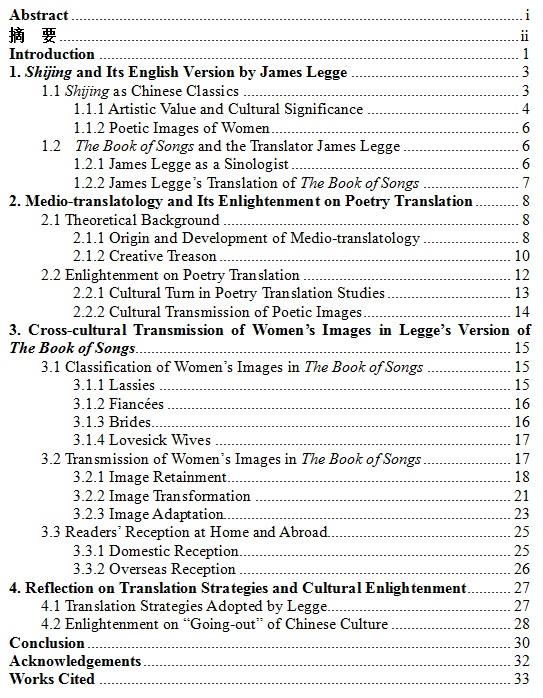
| 文档价格: | 1000金币立即充值 | 包含内容: | 完整论文 | 文章下载流程 | |||||
| 文章字数: | 13291 字 (由Word统计) | 文章格式: | Doc.docx (Word) | 本站文章可以通过查重吗? |
译介学视域下的理雅各《诗经》译本中女子意象的再创造
Recreation of Women’s Images in James Legge’s Version of The Book of Songs from the Perspective of Medio-Translatology
Abstract
Being the earliest collection of poetry, The Book of Songs collects the poetry from the early Western Zhou Dynasty to the middle Spring and Autumn Period, which embarks on the poetic tradition of ancient China. As a mirror of social life in the Zhou Dynasty, its content is abundant, involving labor, love, war, ancestor worship and other aspects. Due to its important historical and cultural status, The Book of Songs has attracted much attention since the starting of cultural exchanges between China and the West. The famous western missionary and sinologist James Legge conducted three retranslations of The Book of Songs and published three versions from 1871 to 1879.
Just as Robert Frost argued that “Poetry is what gets lost in translation”, some scholars believe that poetry is untranslatable. From the perspective of comparative culture, medio-translatology takes “creative treason” as the core of the theory, and puts forward that different cultural contexts not only affect the translator’s choice of translation and translation strategies, but also influence readers’ understanding and acceptance of translated works. This provides references for solving the untranslatability of poetry.
From the perspective of medio-translatology, this thesis analyzes the cross-cultural re-creation of women’s images in Legge’s 1871 The Book of Songs to explore translator’s “creative treason” in the process of translation and the cross-cultural variation of cultural images, which provides reference for the “going-out” of Chinese culture.
This thesis is divided into five parts: the first part describes the research background, purpose and significance; the second part introduces the creation background and aesthetic values of The Book of Songs, and introduces the cultural connotation of its women’s images. It also gives an introduction to the sinologist James Legge and his version of The Book of Songs; the third part introduces the theory of medio-translatology, and discusses the enlightenment of translator’s “creative treason” on literary translation; the fourth part is based on the classification of women’s images in The Book of Songs. It analyzes the retainment, transmission, and adaptation of women’s images in Legge’s translations, discussing the aesthetic effects they produce and summarizing his translation strategies. Legge insists on “faithfulness” principle and adopts foreignization strategy, though he made some mistranslations due to his Confucian studies; the fifth part discusses the overseas acceptance and influence of Legge’s different versions, and explores its enlightenment on the translation of Chinese poetry and the Chinese culture’s “going-out”, that is, combining cultural communication and cultural value, integrating domestication with foreignization, as well as the cooperation between Chinese scholars and foreign translators.
Key words: The Book of Songs; James Legge; women’s image; creative treason
